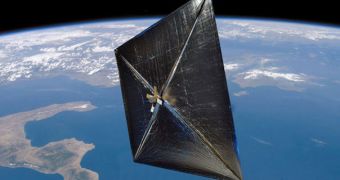Officials at the American space agency announce that NanoSail-D, the first solar sail prototype successfully launched by NASA, will remain in Earth's orbit for a few extra months. The mission was prolonged due to its tremendous results, scientists say.
This will also give amateur astronomers and satellite trackers the ability to continue observing the minute spacecraft for a few more weeks. The reason for delaying the solar sail's deorbiting is that its orbit decays a lot slower than experts calculated.
When an object lies in orbit around a planet, it suffers minute deviations from the optimal path. Over time, these deviations accumulate to such an extent that the spacecraft, moon or any other object veers off course, and slowly starts to make it way to the planetary surface.
This process is called orbital decay, and it affects all satellites in Earth's orbit, including the International Space Station (ISS). Spacecraft that are needed to stay aloft longer than a certain period of time need to be outfitted with small boosters, which adjust the orbital path every once in a while.
Initially, NanoSail-D was supposed to remain aloft for 70 to 120 days. The demonstrator launched aboard the Fast, Affordable, Science and Technology Satellite (FASTSAT) , on November 20, 2010.
Take-off took place from the Kodiak Launch Complex, in Alaska, and the solar sail experiment was accompanied by five others. Its main goal was to test sail deployment technologies, as well as the basic of solar navigation.
The United States were pushed into this area of research after Japan managed to take the world by surprise when it demonstrated its IKAROS solar sail was able to steer using sunlight alone.
Nanosail-D was the swift response. Its sail was unfurled on January 20, and the entire satellite was expected to reenter the Earth's atmosphere within three months. However, new analysis of its orbit seem to indicate that this will not happen until July.
“NanoSail-D has lowered its altitude above the Earth by approximately 28 miles (45 kilometers) from its original altitude of 400 miles (640 km), and continues to descend,” explained Dean Alhorn.
The expert, who is the principal investigator for NanoSail-D at the NASA Marshall Space Flight Center, made the announcement in an April 26 statement.
It is now estimated that “NanoSail-D will continue to descend and eventually re-enter Earth's atmosphere and disintegrate six months to one year from sail deployment,” the expert added.
“The NanoSail-D mission is NASA's first compact structure to deploy in low-Earth orbit and will be the first solar sail to deorbit,” explains MSFC FASTSAT project scientist Joe Casas, quoted by Space.
“The NanoSail-D mission continues to provide a wealth of data that will be useful in understanding how these type of deorbit devices react to the upper atmosphere.” he concludes.

 14 DAY TRIAL //
14 DAY TRIAL //